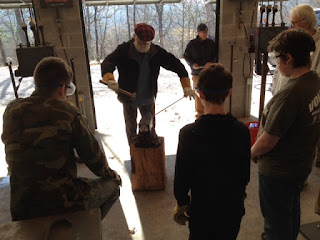Last night we had a very successful fundraiser/art auction at the Rogue's Castle Manor outside Eureka Springs. I sold a cabinet from my book
Building Small Cabinets and two boxes and of course my own contributions were dwarfed by the generosity of so many other artists. Clear Spring School is not supported by tax dollars and community support is essential. We are relieved to have the fundraiser complete for this year.
As part of my review of materials for my trip to Portland, I've posted the essay by David Henry Feldman,
The Child As Craftsman online where my readers can access it.
There is a natural inclination that has not been fully studied, for children to differentiate themselves from each other. For instance, when one sibling may be really good at sports, the other may choose to gain notice in the field of academics. So it happens not just in schools but also in homes.
When I was a very small child, I faced competition and correction from my sister Ann. As children, we were always supplied with colors, paper and paints, and she became the "artist" of the family. Comparing my own work with hers, I felt inept, and she reminded my constantly of her superior skills by drawing on my paper as well as her own. These kinds of early childhood experiences add up and are mulched into our perceptions of self.
David Henry Feldman is a recognized expert in child development whose primary focus has been on the highly gifted child. His paper,
the Child as Craftsman is one I've referred to many times before in the blog, and I make it available here with his permission, as I believe it is important.
If you understand the child's need to differentiate and distinguish him or her self through the development of some specialized skill you realize that a one size fits all standard of schooling ignores the educator's most important assets... the child's own inclination to develop and grow.
But then of course most schools have long ignored the basics of child development. Great universities of education tend to ignore child development, as what teacher, given the current standards in class size, has any time or opportunity to consider the needs of an actual child?
Looking at education through the lens that Piaget offered, we know that children are pushed beyond their developmental levels consistently, forcing them to hate schooling.
When I started out as a woodworking teacher, I had hoped that I might help others to understand the value of hands on learning. I found the problems in education to be far greater than I imagined. But the hands provide a lens on learning. If we look at education from the perspective of the hands, and understand the essential role that the hands through craftsmanship (whether in the wood shop, or practice studio, or laboratory) can play, we are given a simple formula for educational renewal: Put the hands to work in support of learning.
The image above is our newspaper box which has been taken over once again by a nesting wren. It happens this same time each year, and my wife has suggested we simply go with the flow of nature rather than attempt to fight with the inevitable: hence the sign to alert the newspaper carrier to avoid the box. There are some things we can change and some things we should change and some things we must change. One thing that we should, could and must change involves the education of our children. Would it not be best if we were to put their natural passions to work in our own behalf? Unlike wrens which are absolutely true to their own species and standardization, human beings are programmed toward diversity of skills and individual adaptations upon which our culture and civilization are fabricated.
Friend and shop teacher Jonathan Dietz at Weston Middle School in Weston, Massachusetts outside Boston has offered
a gallery of his student's work. The
collection consists of band sawn boxes, assembled boxes, small tables
an a number of small interesting things of the student's own design.
Make, fix, create, and extend to others the opportunity to learn likewise.
 It reminded me that all kids should have the kind of understanding of material properties that engagement in crafts can supply. We use products each day that are based on metallurgical research and material expertise. My students' work in the blacksmith studio at ESSA may make them even smarter about wood and about tools. When I asked my student later whether letting his piece of iron cool slowly had any effect on his ability to cut it with the saw, he said, "it cut like butter."
It reminded me that all kids should have the kind of understanding of material properties that engagement in crafts can supply. We use products each day that are based on metallurgical research and material expertise. My students' work in the blacksmith studio at ESSA may make them even smarter about wood and about tools. When I asked my student later whether letting his piece of iron cool slowly had any effect on his ability to cut it with the saw, he said, "it cut like butter."










































